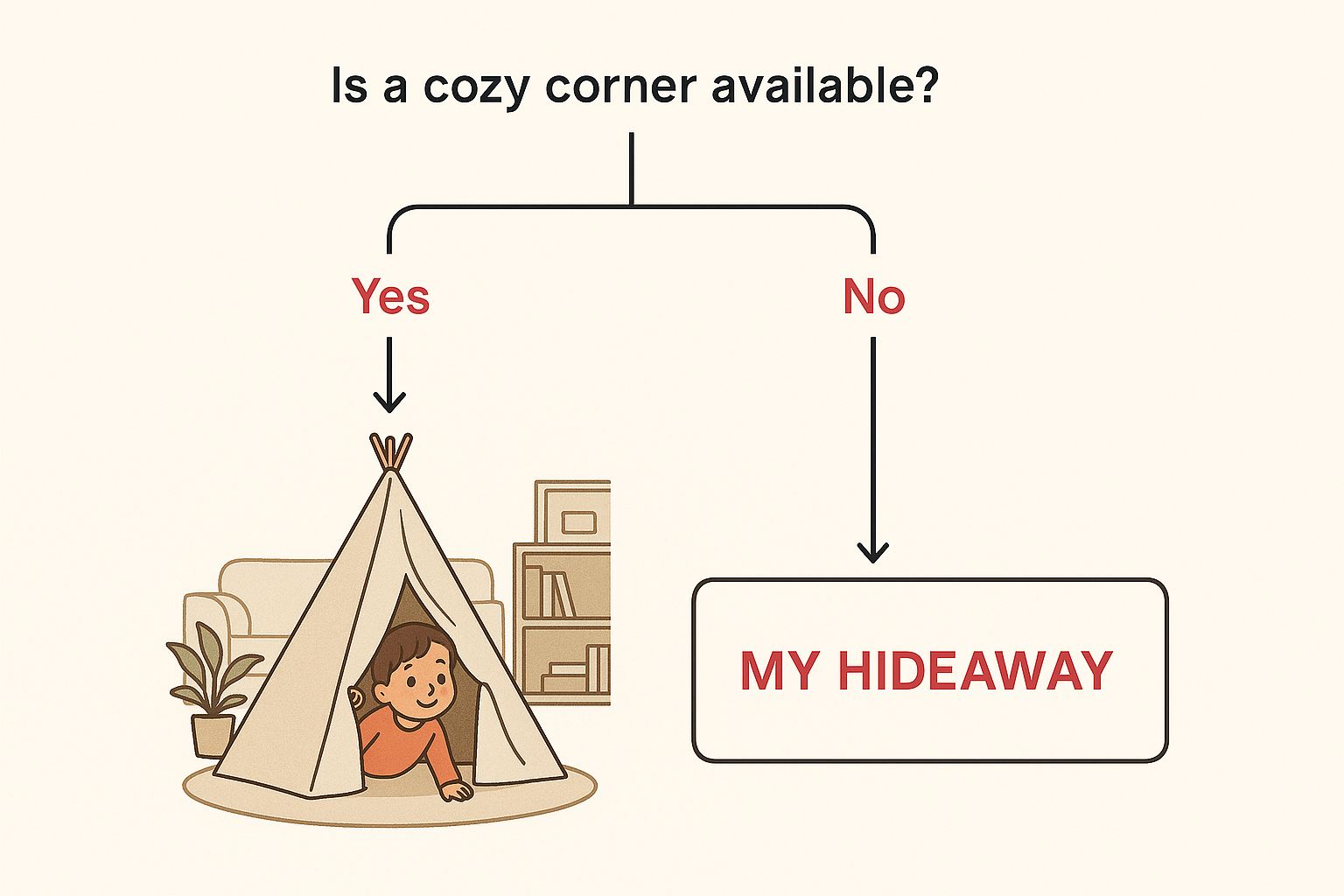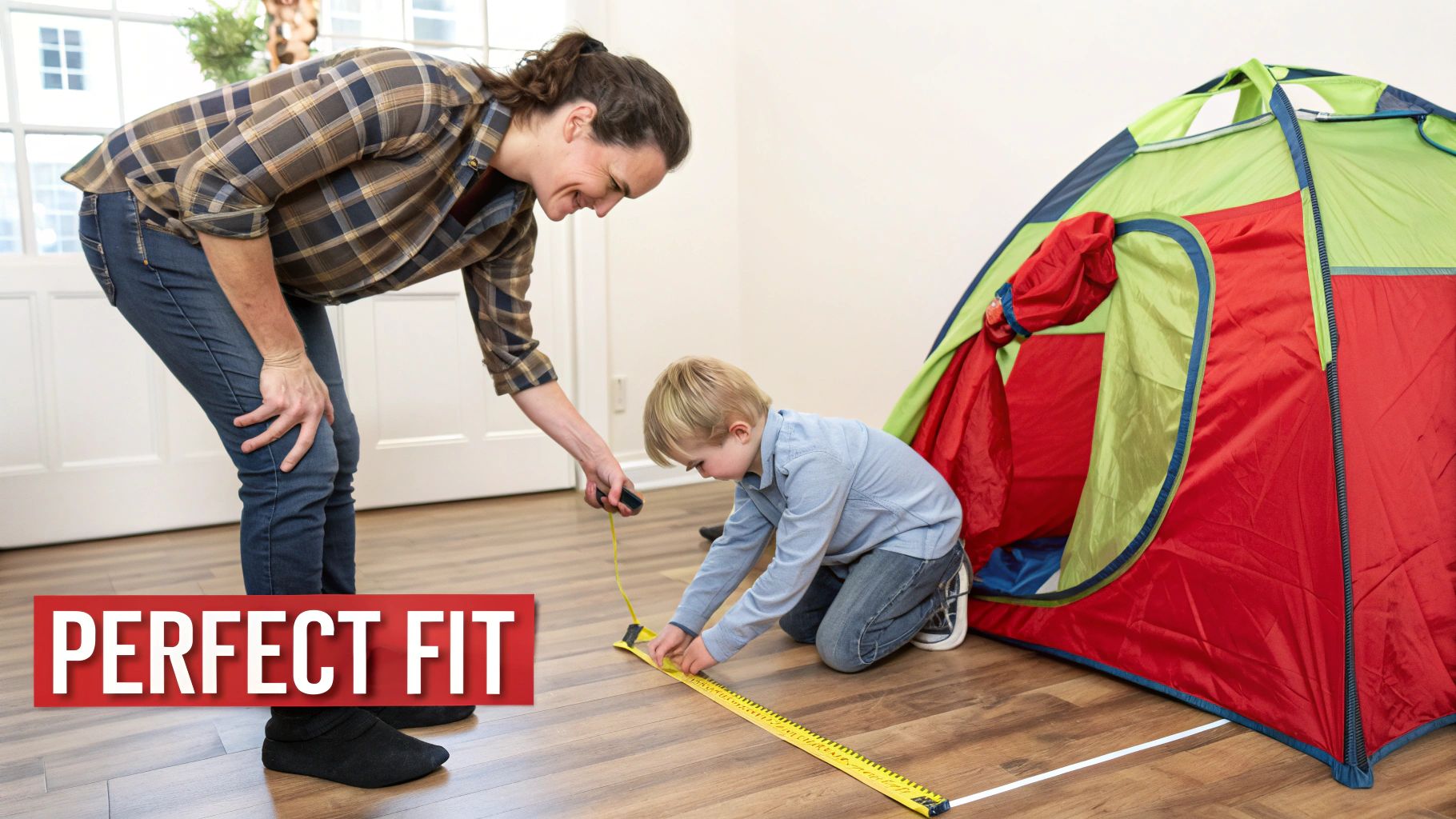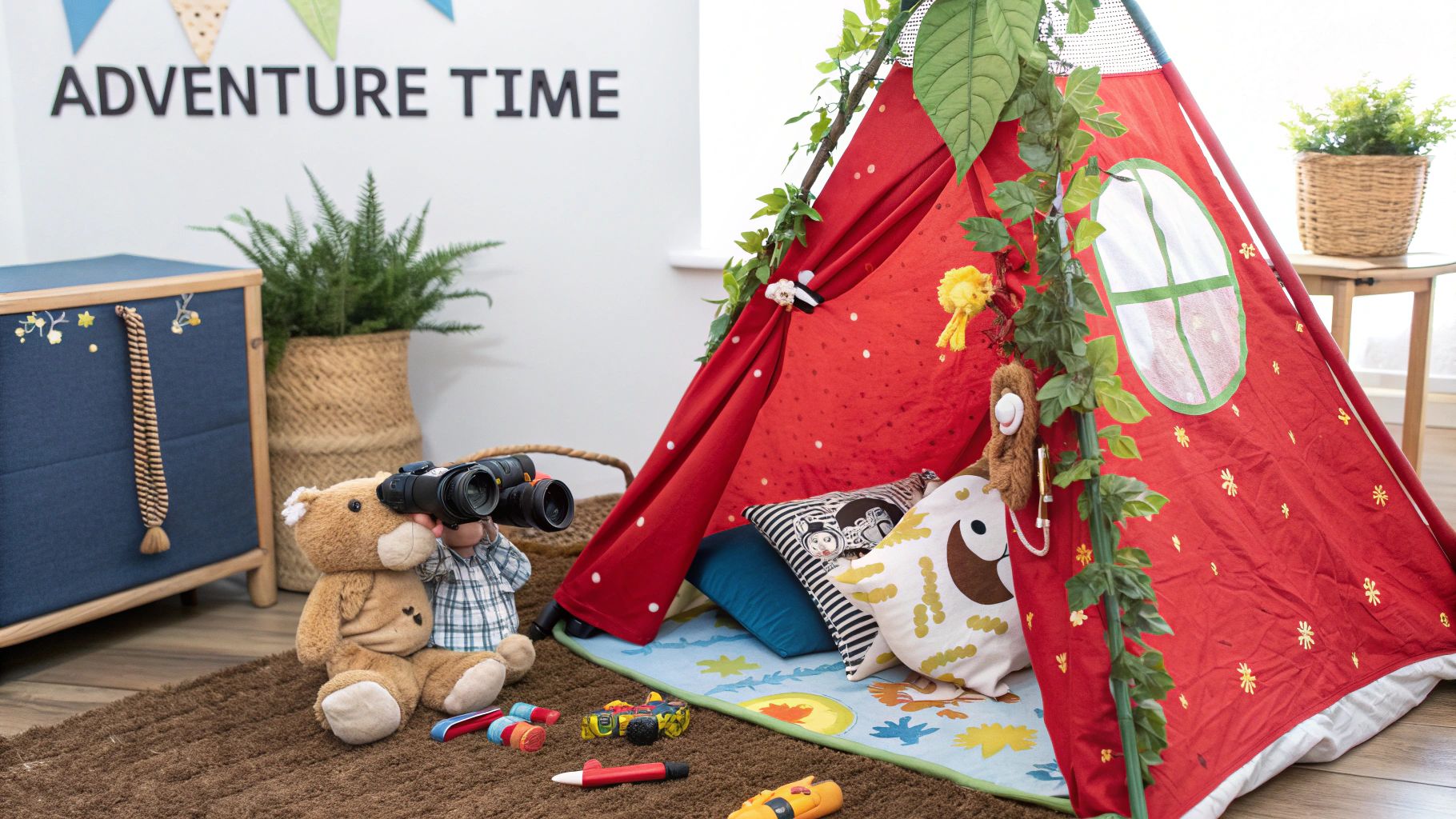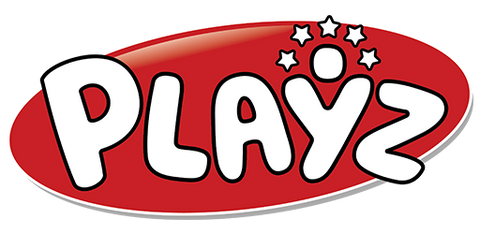
Your Guide to the Best Play Tents Indoor
An indoor play tent is so much more than just a toy. It's a private little world where your child's imagination can run wild. Think of this simple fabric structure as their personal hideaway, a safe space that nurtures independence, creativity, and a sense of security away from the busy family hustle.
The Magic of a Personal Hideaway
Remember building blanket forts? A play tent is your child's first official clubhouse or secret fort—a space that is entirely their own. This is a huge deal for their development. Inside those walls, they are the master of their universe, a role that builds confidence and invites them to express themselves freely.
This personal sanctuary offers some real psychological benefits, too. It’s a quiet corner to process big feelings, a safe spot to retreat to when feeling overstimulated, and a private stage for trying out new ideas. Before you know it, this dedicated area becomes the heart of your child’s playtime, offering a fantastic screen-free alternative for entertainment.
It's easy to see how central these little hideaways can become in a child's world.

The tent acts as a secure, personal space that's separate yet still connected to the family home, perfectly illustrating its role in fostering that budding independence.
A Growing Trend in Modern Playrooms
Parents everywhere are catching on. The global market for kids' playhouses, which includes play tents indoor, was valued at around $2 billion in 2025 and is expected to hit about $3.5 billion by 2033. This growth is all thanks to parents looking for toys that support both imaginative and social development. You can dig into more market insights over at DataM Intelligence.
A play tent gives a child a sense of ownership and control, which are foundational for developing self-esteem. It’s their own little home within a bigger home, a place where their rules and stories are the most important.
This guide will walk you through choosing, setting up, and getting the most out of a simple fabric structure. By understanding their value, you can transform a simple play tent into one of the best toys for imaginative play your child will ever have. Let's get started on turning it into a treasured retreat that supports growth and sparks joy.
How to Choose the Perfect Play Tent

Finding the right indoor play tent can feel a lot like house hunting, but for a pint-sized person. With so many styles, themes, and sizes out there, the options can get a little overwhelming. You want something that fits your space, sparks your kid's imagination, and can actually survive their enthusiastic play sessions.
Before you even start browsing, grab a tape measure. Seriously. The #1 mistake I see parents make is getting a tent that’s either way too big for the room or too small for any real play. Measure the floor space and ceiling height where you plan to set it up, and don't forget to leave some wiggle room around the edges for kids to get in and out easily.
Material and Safety First
When it comes to our kids, safety is always the top priority. Look for tents made with durable, non-toxic materials. The fabric needs to be tough enough to handle some pulling and stretching, and the poles should be strong yet flexible—fiberglass or solid wood are both great options.
Good ventilation is another must-have safety feature, but it's one that often gets overlooked. Tents with mesh windows or roll-up doors keep the air flowing, which prevents things from getting hot and stuffy inside. This is especially important during high-energy play.
Think of a play tent's safety features as its foundation. Durable, non-toxic materials and good ventilation aren't just extras; they are the essential elements that ensure the tent is a secure and healthy environment for your child's adventures.
Comparing Popular Indoor Play Tent Styles
Not all play tents indoor are created equal. Different designs are built for different needs, so thinking about how your family will use it is key. A simple pop-up tent is a lifesaver for small spaces because it folds down flat in seconds. On the other hand, a classic canvas teepee often looks like a beautiful piece of decor and can become a more permanent fixture in a playroom.
To give you a clearer picture, here’s a quick breakdown of the most common styles.
Comparing Popular Indoor Play Tent Styles
| Tent Type | Best For | Ease of Setup | Portability/Storage | Durability |
|---|---|---|---|---|
| Pop-Up Tent | Small spaces, quick play, travel | Super easy (springs into shape) | Excellent (folds flat) | Varies, can be less sturdy |
| Teepee | Stylish rooms, reading nooks | Moderate (requires pole assembly) | Fair (collapses but bulky) | Very good (canvas & wood) |
| Tunnel Tent | Active play, siblings, playdates | Moderate (multiple pieces) | Good (breaks down into parts) | Good (designed for crawling) |
This table should help you narrow down the best fit based on what matters most to you—whether it's quick setup, long-term durability, or creating an awesome play zone. To explore a wide variety of designs, you can check out this great collection of play tents for imaginative fun.
Finally, don't forget about the theme! Does your kid dream of blasting off to space, defending a castle, or camping in the wild? Choosing a design that speaks to their interests will turn a simple tent into their absolute favorite hideout. It sets the stage for countless stories and adventures, making it a toy they’ll come back to again and again.
Unlocking Key Developmental Benefits
An indoor play tent is so much more than just another toy—think of it as a powerful engine for your child's development. This private, kid-sized space becomes their own little laboratory where they can test out new ideas, navigate social situations, and build essential life skills, all while having a blast. It’s a genuine investment in their growth.
Inside that little tent, imagination runs wild. One day it’s a vet clinic for stuffed animals, and the next, it's a spaceship blasting off to Mars. This kind of pretend play is absolutely critical for cognitive development, teaching kids how to create stories, solve problems, and think things through step-by-step.
Fostering Social and Emotional Skills
When siblings or friends pile in, the tent instantly transforms into a hub for cooperative play. Suddenly, they have to figure out how to share, negotiate who gets to be the captain, and work together to bring their imaginary world to life. These early lessons in teamwork and empathy are the building blocks for healthy social and emotional growth.
These skills are becoming a huge focus, even in the professional play space. The global family entertainment market is on track to hit $102.8 billion by 2032, and a big chunk of that growth—about 25% of new investments—is going into play areas that support motor skills and learning. It’s the same kind of benefit you get from a simple play tent indoor.
A play tent also gives kids a much-needed private retreat.
For a child, a play tent is a safe haven. It's a quiet place to retreat when the world feels overwhelming, allowing them to regulate their emotions and recharge in a secure, low-stimulus environment.
Having their own personal space gives them a sense of control and independence, which is vital for building confidence and emotional resilience. To really get into this, you can explore the wide-ranging benefits of play-based learning and see just how it shapes a child's mind.
A Hub for Sensory Exploration
Beyond emotional regulation, a play tent can be an amazing sensory station. You can fill it with soft blankets and pillows for a cozy, calming feel or string up some battery-operated fairy lights and colorful scarves to create a vibrant visual wonderland.
This controlled environment helps children process sensory information without feeling overloaded. It lets them engage their senses on their own terms, which is especially helpful for kids who are sensitive to a lot of stimulation. This adaptability makes the tent an incredible tool for supporting all kinds of developmental needs.
Creative Ideas for Your Play Tent
An indoor play tent is so much more than just a pop-up fort. Think of it as a blank canvas, ready and waiting for your child’s imagination to splash some color on it. Moving beyond a simple game of hide-and-seek is where the real magic begins, turning it from a simple toy into the heart of countless adventures.
With just a few simple props you probably already have lying around, you can set the stage for hours of creative play and keep things fresh and exciting.

The trick is to think thematically. When you create a specific "world" inside the tent, you’re providing the sparks that ignite amazing stories and role-playing. Best of all? You don't need to spend a dime. Everyday household items are often the best tools for the job.
Transform Your Tent into a Cozy Reading Nook
One of the easiest and most impactful transformations is turning the play tent into a dedicated reading corner. This simple act carves out a calm, distraction-free zone that makes picking up a book feel like a special treat instead of a chore. The whole point is to make it as cozy and inviting as possible.
Here’s how to create the perfect little literary escape:
- Soft Lighting: String up some battery-powered fairy lights or place a child-safe lamp just outside the entrance for a warm, magical glow.
- Plush Comfort: Pile in the soft pillows, fluffy blankets, and maybe a favorite stuffed animal to serve as a reading buddy.
- Easy Access: Keep a small basket of their favorite books right inside the tent so their next adventure is always within arm’s reach.
Blast Off in a Space Explorer Cockpit
Got an aspiring astronaut on your hands? The play tent can easily become the command center of a rocket ship hurtling through the galaxy. This theme is fantastic for sparking an interest in science and encouraging some creative problem-solving. It’s all about creating a high-tech feel with some decidedly low-tech props.
To get your mission started, every ship needs a control panel. This is where you can get really creative with some simple DIY. For some fantastic inspiration, check out these fun and easy cardboard craft ideas that can be easily adapted for your cockpit.
A play tent’s greatest strength is its versatility. With a few themed props, it can be a castle one day and a submarine the next, endlessly adapting to a child’s changing interests and developmental stages.
Establish a Jungle Research Base
Turn your living room into a dense, mysterious jungle with a research base right in the middle of it all. This theme is an absolute winner for kids who love animals and nature, pushing them to observe, explore, and document their "findings."
Make sure your little explorer is properly equipped with these essential tools:
- Binoculars: A pair of toy binoculars is a must for spotting exotic wildlife. Don't have any? Two cardboard tubes taped together work just as well.
- Stuffed Animals: Scatter stuffed monkeys, tigers, and parrots around the "jungle" (your living room) for your researcher to discover on their expedition.
- Research Tools: A clipboard, some paper, and a few crayons are all they need to draw and take notes on the fascinating creatures they encounter.
Each of these ideas takes just a few minutes to set up but can unlock hours of rich, imaginative play. The goal is to see the play tent indoor not just as a physical structure, but as a versatile stage ready for any story your child can dream up.
Setup, Safety, and Simple Maintenance
You've found the perfect tent! Now what? A smooth setup and a few simple rules are all it takes to make it a safe, lasting part of your home. Taking a couple of extra minutes during assembly isn't just about preventing the frustration of a torn seam or a bent pole; it's about laying the groundwork for hours of worry-free play.
Most play tents indoor come with pretty clear instructions, but a little patience always helps. If you've got a pop-up model, make sure you have plenty of clear space before you let it spring open—you don't want it knocking over a lamp. For teepees, get each pole fully seated in its fabric sleeve before you stand it up. This simple step prevents putting too much strain on the seams.
Your Peace-of-Mind Safety Checklist
Before the kids come stampeding in, do a quick safety walkthrough. A secure and well-placed tent isn't just a toy; it's a sanctuary where they can let their imaginations run wild. Where you put the tent is just as important as how you build it.
Here are a few non-negotiables for a safe setup:
- Stable and Secure: Give the tent a gentle shake. Does it feel solid? If it's wobbly, take a moment to readjust the poles until it feels sturdy on its feet.
- Clear the Zone: Keep the tent away from heaters, fireplaces, and electrical outlets. A good rule of thumb is to maintain a distance of at least three feet from any heat source.
- Check for Airflow: Make sure any flaps or windows are easy to open and aren't blocked by furniture. Good ventilation keeps the inside comfortable and safe during those long play sessions.
- No Cords Nearby: Position the tent well away from window blind cords or other electronics to eliminate any risk of entanglement.
Keeping the Tent Fresh and Clean
Let's be real: kids are messy. Their favorite hideout is bound to collect a few crumbs, crayon marks, and some general grime. The good news? Keeping a play tent clean is usually pretty straightforward. A little upkeep not only keeps it looking great but also ensures it's a hygienic space for your little ones.
For most minor spills, spot-cleaning with a damp cloth and mild soap will do the trick. Always check the manufacturer’s tag first, though! Some tents have removable fabric covers that you can toss in the washing machine on a gentle cycle. To take your organization game to the next level, check out these tips on how to organize a toy room, which can help keep the entire play area in great shape.
Proper storage is the secret to making a play tent last. Always make sure the tent is completely dry before folding it away to prevent mildew. Tucking it back into its original bag protects it from dust and damage, keeping it ready for the next big adventure.
What’s Next for Indoor Play Tents?
The good old play tent is getting a serious upgrade. What used to be a simple fabric fort is now becoming smarter, more eco-friendly, and way more personal—all things that matter to modern families. The future of play tents indoor isn't just about giving kids a place to hide; it's about thoughtful design that supports how they play and the values we want to teach them.
This change is happening because parents are asking for it. There's a real demand for products that are kinder to the planet and more captivating for kids. We're seeing a huge shift toward sustainable materials like organic cotton, bamboo, and responsibly sourced wood. These options give parents peace of mind, knowing they're bringing something safe and durable into their home. It's a conscious choice.
Smarter and More Immersive Play
Technology is also starting to play a small, but clever, role. Imagine a tent with a built-in projector that splashes a galaxy of stars across the ceiling during story time. Or one with an integrated sound machine that fills the space with calming nature sounds. These aren't screen-based gimmicks; they create immersive environments that can turn a tent into a soothing sensory retreat or the cockpit of an imaginary spaceship.
The next generation of play tents will blend right into family life, offering multi-sensory experiences that are both educational and enchanting. They’ll be designed to grow with a child, adapting from a simple fort into a dynamic hub for learning and dreaming.
Personalization is another big trend on the horizon. Soon, families will be able to pick custom colors, add embroidered names, or even choose modular pieces to build a tent that fits their space and their child's personality perfectly. This isn't happening in a vacuum—it mirrors what's going on in the wider toy industry, where sustainable materials and tech-enhanced features are booming. You can learn more about these evolving toy tent trends to see just how much the market is changing.
Frequently Asked Questions About Indoor Play Tents
Even after you’ve picked out the perfect spot, a few questions always seem to pop up. Let’s tackle some of the most common ones I hear from parents trying to make that final decision.
What’s the Best Age for a Play Tent?
While a simple pop-up tent can be a delight for toddlers as young as 12 months, the real magic happens between ages 3 and 8. That's the sweet spot.
During these years, a child's imagination is just firing on all cylinders. The tent becomes a castle, a spaceship, a secret lab—you name it. For the little ones, it’s a cozy sensory spot, but for older kids, it's the headquarters for complex games or just a quiet place to get lost in a book.
I Live in a Small Apartment. Can I Still Get a Tent?
Absolutely. Living in a tight space doesn’t mean you have to skip the fun; you just have to be a bit more strategic.
- Pop-Up Tents: These are your best friend in a small home. They literally spring to life in seconds and, just as important, collapse down flat enough to slide under a bed or stand up in a closet.
- Corner Teepees: A classic teepee has a much smaller footprint. You can tuck it into a corner where it becomes a charming piece of decor instead of a major obstacle.
The trick is finding a tent that’s easy to put away. That way, it feels like a special treat for playtime instead of a permanent piece of furniture you're constantly tripping over.
Are These Tents Safe for Unsupervised Play?
For the most part, yes—but only after you’ve done a quick safety sweep. Make sure the tent has plenty of ventilation and is set up on a flat, stable surface. Keep it away from heaters, stray cords, or any heavy furniture it could get knocked into.
Once you’ve given it the all-clear, a play tent is a fantastic way to encourage independent play. It gives your child a sense of their own space and autonomy, all while staying safely within earshot.
Ready to find that perfect little hideaway to spark your child's imagination? Playz has an amazing collection of durable, creative play tents designed for hours of developmental fun.
